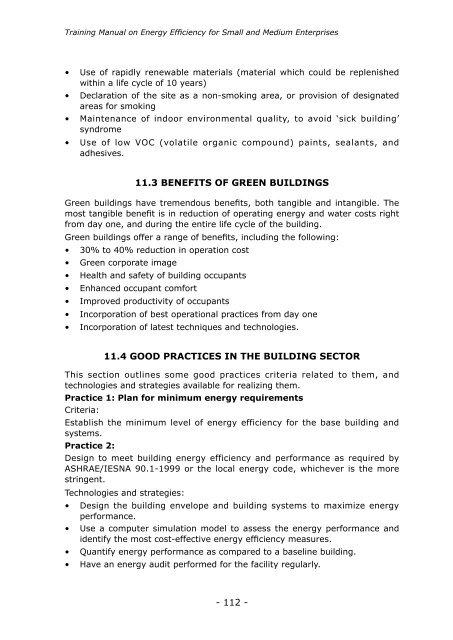Training Manual on Energy Efficiency - APO Asian Productivity ...
Training Manual on Energy Efficiency - APO Asian Productivity ...
Training Manual on Energy Efficiency - APO Asian Productivity ...
You also want an ePaper? Increase the reach of your titles
YUMPU automatically turns print PDFs into web optimized ePapers that Google loves.
<str<strong>on</strong>g>Training</str<strong>on</strong>g> <str<strong>on</strong>g>Manual</str<strong>on</strong>g> <strong>on</strong> <strong>Energy</strong> <strong>Efficiency</strong> for Small and Medium Enterprises<br />
• Use of rapidly renewable materials (material which could be replenished<br />
within a life cycle of 10 years)<br />
• Declarati<strong>on</strong> of the site as a n<strong>on</strong>-smoking area, or provisi<strong>on</strong> of designated<br />
areas for smoking<br />
• Maintenance of indoor envir<strong>on</strong>mental quality, to avoid ‘sick building’<br />
syndrome<br />
• Use of low VOC (volatile organic compound) paints, sealants, and<br />
adhesives.<br />
11.3 BENEFITS OF GREEN BUILDINGS<br />
Green buildings have tremendous benefits, both tangible and intangible. The<br />
most tangible benefit is in reducti<strong>on</strong> of operating energy and water costs right<br />
from day <strong>on</strong>e, and during the entire life cycle of the building.<br />
Green buildings offer a range of benefits, including the following:<br />
• 30% to 40% reducti<strong>on</strong> in operati<strong>on</strong> cost<br />
• Green corporate image<br />
• Health and safety of building occupants<br />
• Enhanced occupant comfort<br />
• Improved productivity of occupants<br />
• Incorporati<strong>on</strong> of best operati<strong>on</strong>al practices from day <strong>on</strong>e<br />
• Incorporati<strong>on</strong> of latest techniques and technologies.<br />
11.4 GOOD PRACTICES IN THE BUILDING SECTOR<br />
This secti<strong>on</strong> outlines some good practices criteria related to them, and<br />
technologies and strategies available for realizing them.<br />
Practice 1: Plan for minimum energy requirements<br />
Criteria:<br />
Establish the minimum level of energy efficiency for the base building and<br />
systems.<br />
Practice 2:<br />
Design to meet building energy efficiency and performance as required by<br />
ASHRAE/IESNA 90.1-1999 or the local energy code, whichever is the more<br />
stringent.<br />
Technologies and strategies:<br />
• Design the building envelope and building systems to maximize energy<br />
performance.<br />
• Use a computer simulati<strong>on</strong> model to assess the energy performance and<br />
identify the most cost-effective energy efficiency measures.<br />
• Quantify energy performance as compared to a baseline building.<br />
• Have an energy audit performed for the facility regularly.<br />
- 112 -
















